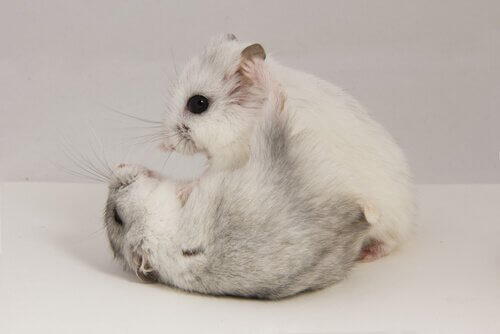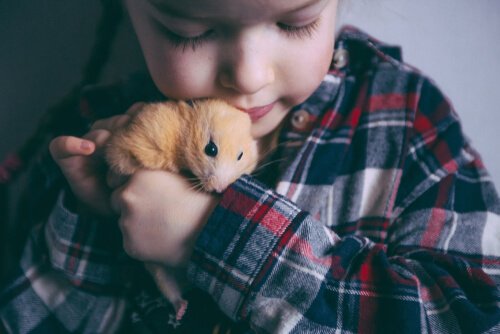Small but Fierce: How to Tame a Hamster


Written and verified by the biologist Paloma de los Milagros
Lots of kids out there love animals. If yours are itching for a furry friend, a hamster can be a great alternative in terms of responsibility and cost. Neither is it too difficult to tame a hamster.
Hamsters are small rodents that belong to the subfamily Cricetinae. Some of the most common varieties are the Golden hamster, the Roborovski hamster, the Russian Dwarf hamster, Campbell’s Dwarf hamster, and the Chinese hamster.
Hamsters are much easier to care for than other kinds of pets. Along with their small size and sociable natures, this makes them one of the best, most popular options for kids. But, like any pet, you still have to be a responsible owner with a hamster. You’ll have to tame yours in order for things to go smoothly.
We should also mention that having lots of hamsters tends to lead to aggressive behavior. They’re generally very territorial and solitary. Because of that, if they feel like something is threatening to take their space or food, they might start quite violent fights. These fights don’t always have happy endings.

How to tame a hamster
Here are some of the most important tips on how to tame a hamster:
Living conditions
If you’re going to get a hamster, you need to make sure it has good living conditions. This is more than just about getting it a big cage and making sure it has a clean environment and a good diet.
If you have kids, you also have to make sure they understand that it’s not a toy. It’s a living thing that they need to respect and care for.
The first few days
When you first get your hamster, you should focus that time on helping it get used to its new home. It’s best not to touch it from outside the cage. Because of their fearful nature, experts say it’s best to let hamsters get used to your presence or voice first.
Taking it out of the cage
The first time you’re going to take it out of its cage, open its door, but don’t pick it up. Offer it your hand so that it can recognize you, and maybe even give it food as a kind of “reward”. This will help it to have a positive attitude towards you.
Picking it up
Once you start to feel like it’s getting comfortable around you, then you can try to pick it up. Just remember to be extremely careful, and make sure your kids know that too.

Playing
The more time you spend with the hamster, and the more comfortable it feels around people, the more willing it will be to play games. Like any pet (and even more so with mammals and birds), stimulation is key.
Any kind of ball, tunnel, set of stairs, or wheel will give it a way to have fun. At the same time, it will also learn to do new things and stay in shape.
Be careful with toys
Although all the toys we just listed can be great for a hamster, using them incorrectly can also put its health, or life, at risk. One good example of that are hamster balls. These are the kind that hamsters can go inside and roll around in outside their cage. If you push the ball, instead of letting the hamster do it itself, it could go too fast and get hurt.
Bites
Lastly, if you want to prevent your hamster from biting you, you need to be calm around it. Never interrupt it when it’s eating, drinking, or sleeping. Hamsters tend to be more active at night, or during the later hours of the afternoon, so those might be better times to interact.
All the tips we’ve listed here are a good example of how taming a hamster is a relatively intuitive process. You basically just have to be patient about creating a bond and be delicate whenever you’re stroking it or playing with it.
Just because they’re small and seem easy to care for doesn’t mean they shouldn’t get the same respect and commitment as any other pet.
Lots of kids out there love animals. If yours are itching for a furry friend, a hamster can be a great alternative in terms of responsibility and cost. Neither is it too difficult to tame a hamster.
Hamsters are small rodents that belong to the subfamily Cricetinae. Some of the most common varieties are the Golden hamster, the Roborovski hamster, the Russian Dwarf hamster, Campbell’s Dwarf hamster, and the Chinese hamster.
Hamsters are much easier to care for than other kinds of pets. Along with their small size and sociable natures, this makes them one of the best, most popular options for kids. But, like any pet, you still have to be a responsible owner with a hamster. You’ll have to tame yours in order for things to go smoothly.
We should also mention that having lots of hamsters tends to lead to aggressive behavior. They’re generally very territorial and solitary. Because of that, if they feel like something is threatening to take their space or food, they might start quite violent fights. These fights don’t always have happy endings.

How to tame a hamster
Here are some of the most important tips on how to tame a hamster:
Living conditions
If you’re going to get a hamster, you need to make sure it has good living conditions. This is more than just about getting it a big cage and making sure it has a clean environment and a good diet.
If you have kids, you also have to make sure they understand that it’s not a toy. It’s a living thing that they need to respect and care for.
The first few days
When you first get your hamster, you should focus that time on helping it get used to its new home. It’s best not to touch it from outside the cage. Because of their fearful nature, experts say it’s best to let hamsters get used to your presence or voice first.
Taking it out of the cage
The first time you’re going to take it out of its cage, open its door, but don’t pick it up. Offer it your hand so that it can recognize you, and maybe even give it food as a kind of “reward”. This will help it to have a positive attitude towards you.
Picking it up
Once you start to feel like it’s getting comfortable around you, then you can try to pick it up. Just remember to be extremely careful, and make sure your kids know that too.

Playing
The more time you spend with the hamster, and the more comfortable it feels around people, the more willing it will be to play games. Like any pet (and even more so with mammals and birds), stimulation is key.
Any kind of ball, tunnel, set of stairs, or wheel will give it a way to have fun. At the same time, it will also learn to do new things and stay in shape.
Be careful with toys
Although all the toys we just listed can be great for a hamster, using them incorrectly can also put its health, or life, at risk. One good example of that are hamster balls. These are the kind that hamsters can go inside and roll around in outside their cage. If you push the ball, instead of letting the hamster do it itself, it could go too fast and get hurt.
Bites
Lastly, if you want to prevent your hamster from biting you, you need to be calm around it. Never interrupt it when it’s eating, drinking, or sleeping. Hamsters tend to be more active at night, or during the later hours of the afternoon, so those might be better times to interact.
All the tips we’ve listed here are a good example of how taming a hamster is a relatively intuitive process. You basically just have to be patient about creating a bond and be delicate whenever you’re stroking it or playing with it.
Just because they’re small and seem easy to care for doesn’t mean they shouldn’t get the same respect and commitment as any other pet.
All cited sources were thoroughly reviewed by our team to ensure their quality, reliability, currency, and validity. The bibliography of this article was considered reliable and of academic or scientific accuracy.
- La Madriguera. (2015). Asociación Protectora de Pequeños Animales. Recuperado de http://www.madrigueraweb.org/articulo/cuidados-basicos-de-los-hamsters
- MedVet. (2016). Hamster information and care recommendations. Recuperado de https://www.medvetforpets.com/hamster-information-care-recommendations/
- National Geographic Kids. (2014). Hamsters: From the wild to your bedroom. Recuperado de https://kids.nationalgeographic.com/explore/nature/wild-hamsters/
This text is provided for informational purposes only and does not replace consultation with a professional. If in doubt, consult your specialist.








